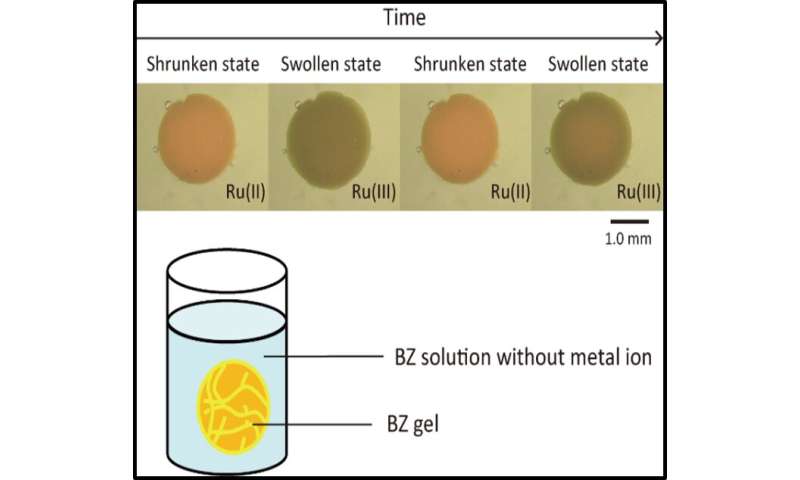
Modern mechatronic devices, from industrial machinery to robots, have seen a drastic increase in complexity and intricacy. With sophisticated functionalities being unlocked with each passing day, there has been an inevitable rise in the number of components that the devices need. And although these advancements are undeniably impressive, the sheer bulkiness and large number of components are a major hindrance to the "miniaturization" and cost-effectiveness of these devices.
But what if, instead of using multiple bulky components, we find a smarter way to build them? This is what scientists, including Prof Shingo Maeda, Dr. Zebing Mao (Smart Materials Laboratory, Shibaura Institute of Technology) and Dr. Vito Caccuciolo (Soft Transducers Laboratory, Institute of Microengineering, École Polytechnique Fédérale de Lausanne), have worked on, in a recent study published in Scientific Reports. The scientists explored the possibility of various components of an electromechanical device—like the power supply, actuators, and control system—being reduced to a single piece of hydrogel. In doing this, they succeeded in creating a self-actuated microfluidic pump driven only by an oscillatory chemical reaction, which successfully produced 'pressurized oil' (representing mechanical work). Prof Maeda, who led the study, says, "We propose a novel method to realize a simple pumping function using a single-component self-oscillating hydrogel and a membrane."
In their study, the scientists focused on a unique type of oscillatory chemical reaction that belongs to the Belousov-Zhabotinsky (BZ) class of reactions. Conventionally, a chemical reaction involves a reactant that gives rise to a product to reach a state of equilibrium. But, BZ reactions, which involve bromine and an oxidizing agent, produce a system that never reaches chemical equilibrium; instead, it goes back and forth between various states. Previously, researchers had observed that hydrogels and other polymers housing a BZ reaction (termed BZ gels) were capable of autonomous motion because the reaction caused slight and periodic structural changes, thus showing a lot of potential in mechatronic applications. But, their practical use has been challenging until now. Prof Maeda explains, "Previously reported BZ gels showed very small displacement and were only tested while submerged inside chemical baths, which clearly limits their potential applications."
In this new study, the scientists overcame this hurdle using a new approach, which is much more promising thanks to an innovative implementation. Prof Maeda explains their methodology, "First, we produce BZ gels and pre-stretch them, which increases the mechanical work that can be extracted at each BZ cycle. Then, the whole gel and its surrounding chemical solution are completely encapsulated. Finally, the mechanical work produced by the swelling and contraction of the gel is transferred to an external oil through the deformation of a stretchable membrane." The result of this is a self-actuating pump solely driven by the oscillating reaction that can move fluids back and forth like an artificial "heart" for machines and produce mechanical work in the form of pressurized oil. The scientists tested the approach both virtually and experimentally, showing that the proposed concept holds potential.
This study sheds light on the fundamental physical mechanisms of BZ gels and indicates a way to improve their mechanical performance. It is an important step toward bridging the technological gap that exists for converting oscillating chemical energy into mechanical energy to power useful devices. Some noteworthy examples of feasible long-term applications of pumps made using BZ gels are in the field of microfluidics, including drug delivery systems, DNA microarrays for biomedical research, and many other biotechnological and nanotechnological tools. The self-actuating pump proposed by the scientists could act as a single-component power source in microfluidic systems, thereby simplifying their design, reducing their cost, and broadening their applicability.
The research team is optimistic about taking their work to the next level in the future, which will involve the optimization of their design through chemical and mechanical methods. This will be key for bringing forth a paradigm shift in the design of electromechanical devices by taking on a more bio-inspired turn. In this regard, Prof Maeda concludes, "Self-actuating pumps bode to break the wall of complexity faced by certain robotic systems with an increasing number of functions, enabling the development of truly smart multi-functional machines."
Explore further
Provided by Shibaura Institute of Technology
Citation: Less is more: A soft, self-actuated pump to simplify mechatronic devices (2020, August 25) retrieved 25 August 2020 from https://ift.tt/3j5ryRA
This document is subject to copyright. Apart from any fair dealing for the purpose of private study or research, no part may be reproduced without the written permission. The content is provided for information purposes only.
"soft" - Google News
August 25, 2020 at 09:37PM
https://ift.tt/3j5ryRA
Less is more: A soft, self-actuated pump to simplify mechatronic devices - Phys.org
"soft" - Google News
https://ift.tt/2QZtiPM
https://ift.tt/2KTtFc8
Bagikan Berita Ini














0 Response to "Less is more: A soft, self-actuated pump to simplify mechatronic devices - Phys.org"
Post a Comment